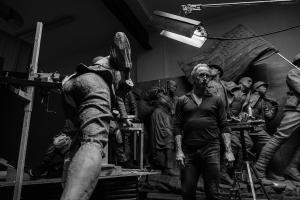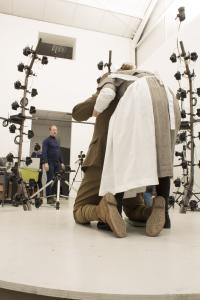
MASTER SCULPTOR SABIN HOWARD USES MODERN TECHNOLOGY TO MAKE MAMMOTH MEMORIAL BY HAND AS ANCIENT ARTISTS DID
Master sculptor Sabin Howard designed, created, and sculpted A Soldier’s Journey, the heart of the WWI Memorial to be installed in Washington, DC next month
KENT, CT, UNITED STATES, August 12, 2024 /EINPresswire.com/ -- Master sculptor Sabin Howard designed, created, and sculpted A Soldier’s Journey, the sculptural heart of the National WWI Memorial to be installed in Washington, DC next month.
After winning the international design competition for the National WWI Memorial in 2016, Howard leapt to design the 60’ Memorial. He set up a platform on which he posed models dressed in actual uniforms that had seen combat. Howard then took photos with his cell phone to get the initial poses. He tasked the models to move through the action from start to finish; he set his phone camera to ‘burst’ mode so he could select the most expressive and kinetic pose that best told the story.
The images were rendered, and re-rendered, together through various iterations until the final story of A Soldier’s Journey was greenlit.
At this point, Howard drew the entire 38-figure composition. Widely considered America’s Michelangelo, Howard is also a master draughtsman. He taught sculpting, figure drawing, and écorché figures in art college and graduate school for twenty years. He used the drawing process to work out his composition so that each figure was sumptuously complete within itself and yet also fit perfectly within the whole.
In the same way, Michelangelo sketched his figures before sculpting them.
When the drawing was complete, Howard took it to Weta Workshop in New Zealand to turn it into a three-dimensional maquette, or model. A photogrammetry process, along with 3-D printing in foam, was used to make multiple models until Howard decided on the depth of the figures.
Howard’s goal was to create a relief that made a visceral impact on the viewer. As he shared with Smithsonian Magazine, “I’m hoping to make something that lets a kid, when he’s walking along the wall, experience it like it’s a movie in bronze... The scenes are changing. And the kid goes home and he’s like, ‘Oh my God, I got to see what World War I was all about.’ And he gets the idea that we’re on a journey—each and every one of us.”
The maquette was then cast in clay for Howard to sculpt. Howard sculpts with fine wax tools, rakes, and knives—even as the ancient Parthenon sculptor Phidias did. Howard plays forward an ancient art in a completely innovative and creative way, reverently embedding the past into tomorrow.
The Commission of Fine Arts in Washington, DC, mindful that A Soldier’s Journey would be installed a block from the White House, requested minor modifications to the first maquette. Howard took that maquette and a team of models to Pangolin-Editions Studio in Stroud, UK, where Steve Russell Studios had an impressive and unique photogrammetry rig consisting of 160 Hasselblad cameras.
Howard posed his team inside the rig and all 160 cameras simultaneously captured each pose. The data from this imagery was fed into a program called Z-brush. Howard worked with the computer technicians to create the images he wanted. From those renderings a second maquette was made. When that maquette was approved, the figures were milled out in CNC foam and covered with a thin coat of clay so Howard could sculpt them.
In the application of clay, Howard has no equal. He works in the most ancient tradition, with a model posing on a stand before him, using the aforementioned tools. He had four and a half years to sculpt 38 figures to the level of Renaissance art, a level that would inspire viewers to learn about WWI as well as uplift them. Indeed, Howard intends to elevate the human spirit with his masterful art.
Howard finished sculpting on time, on budget. The completed sculpture is a magnificent movie in bronze, understood by all who walk from left to right. This mammoth monument honors not just those who shall not be forgotten from the Great War, but also our veterans from all wars.
The National WWI Memorial will be Illuminated in a candle-lit ceremony on September 13, 2024. This event will be live-streamed and covered by National television. Interested journalists should contact Rebecca DeSimone, Esquire.
Rebecca DeSimone, Esquire
Sabin Howard Sculpture LLC
rdrosebud@gmail.com
Visit us on social media:
X
LinkedIn
Instagram
YouTube
Other
Sabin Howard First 11 Figures from Vision to Bronze
EIN Presswire does not exercise editorial control over third-party content provided, uploaded, published, or distributed by users of EIN Presswire. We are a distributor, not a publisher, of 3rd party content. Such content may contain the views, opinions, statements, offers, and other material of the respective users, suppliers, participants, or authors.






